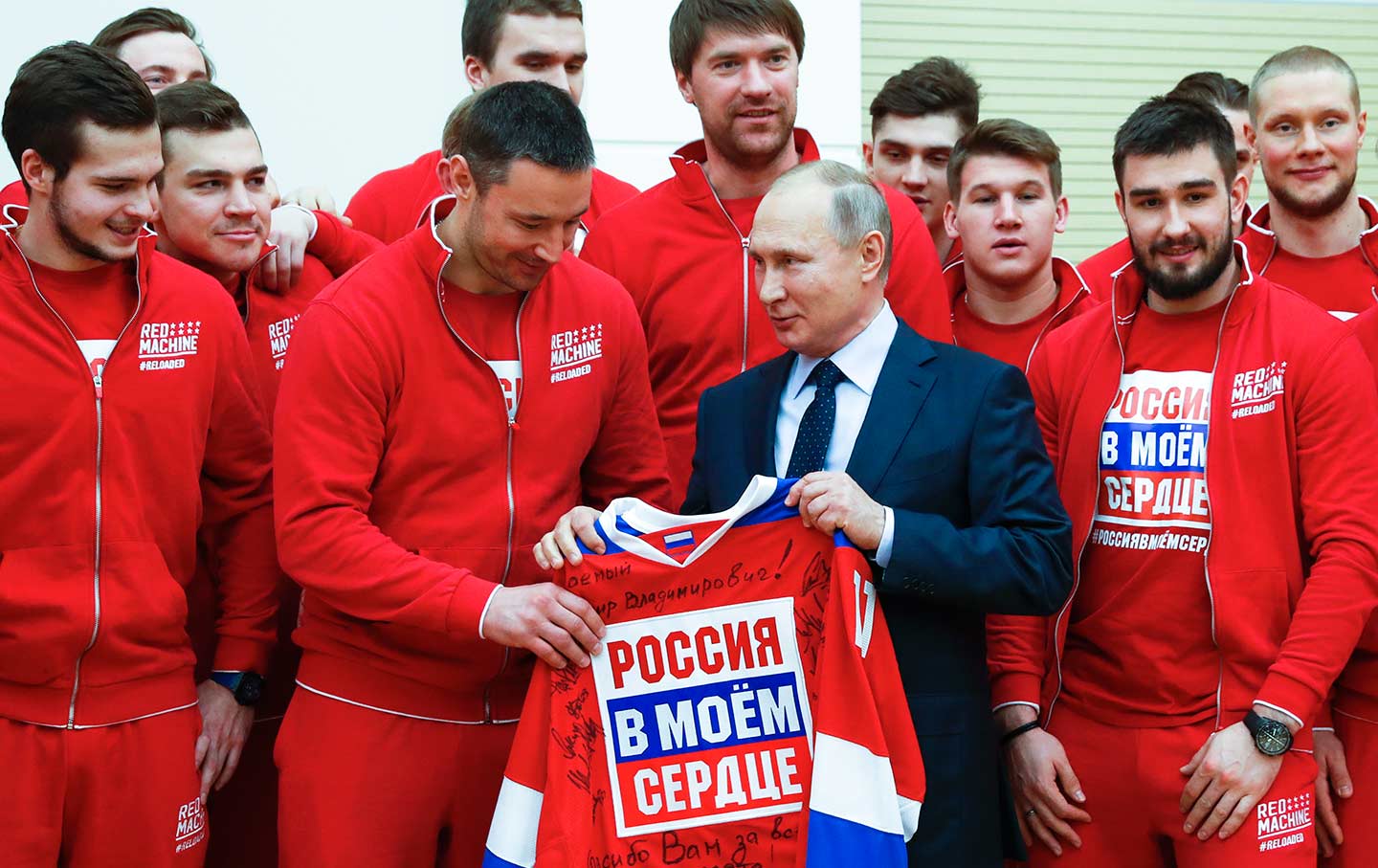
Vladimir Putin poses with the Russian national ice-hockey team, January 2018.(Grigory Dukor / Pool Photo via AP)
This Olympics has introduced the viewing public to the nation of OAR, marked by an out-of-place but familiar five-ringed flag. OAR stands for “Olympic Athletes from Russia,” and this awkward designation along with the Olympic flag is punishment for the doping program used by Russia at the 2014 Winter Games in Sochi. But credible evidence of Russian doping should not mask the hypocrisy of the International Olympic Committee—or the unfair nature of where this burden lands.
The International Olympic Committee knew about institutionalized Russian doping as early as July 2013. Yet it willfully turned a blind eye to hard evidence of doping across the Russian sportscape and allowed the Sochi 2014 Games—along with their billions in graft—to proceed apace. With Russia hosting, it was in the IOC’s interest to look the other way, and it was dutiful in that task. Then, just ahead of the 2016 Rio Summer Games, the IOC punted responsibility to the International Sports Federations to determine whether Russian athletes would be allowed to participate. As more evidence rolled in, and the World Anti-Doping Agency—another organization rife with conflicts of interest and bungled efforts—collected proof of endemic doping in Russia, the IOC announced in December 2017 that the country would be banned from the 2018 Pyeongchang Winter Games.
Then the Olympic honchos attached a massive asterisk to that bold pronouncement, allowing nearly 170 Russian athletes to participate in South Korea—only a handful fewer athletes than the 177 who participated at the 2010 Vancouver Winter Olympics. These athletes had to pass a screening process and prove that they were neither a part of what happened in Sochi nor any institutionalized doping mechanism. That nearly 170 athletes passed raises questions on both sides: How widespread was the doping, and how “rigorous” was the screening process? After all, the IOC was tight-lipped about the criteria that would be used to judge Russian athletes, although it immediately issued the “Olympic Athletes from Russia” logo design. The compromise is that we now have “Olympic Athletes from Russia,” but somehow not Russia—a painfully awkward shirttail through the front zipper.
On the ground, it’s even more laughable. While one might think competing under the OAR designation would be the equivalent of adopting the scarlet letter, it has actually just intensified Russian nationalism at these games.
Russian spectators have traveled en masse and in startlingly large numbers to Pyeongchang, showing pride and thumbing their nose at the IOC. While most countries have hospitality houses emblazoned with their name, the Russians have what they are calling a “Sports House” because they—seriously—are not allowed to call it a “Russia House.” But this house has predictably become a nationalism free-for-all, where nesting dolls, photos of Vladimir Putin, and an unlimited supply of Russian hats, scarves, and flags are all on full display. As Tariq Panja reported from South Korea, “Being unable to use the word Russia or the Olympic rings in the facility’s logo appears to be the only restrictions at the house.”
Imagine if the United States were “banned” from the Olympics in a similar way, yet we still had 95 percent of our athletes’ competing without red, white, and blue uniforms and without the Stars and Stripes waving overhead. US tourists would make South Korea look like the Fourth of July at Lee Greenwood’s house, even if the team just took their skates and went home.
That Russia has chosen to compete is also a finger in the eye to the International Olympic Committee’s demand that athletes and coaches embroiled in doping receive lifetime bans. This demand raised eyebrows in Olympic circles, both because of its harshness—it was never made of a US athlete caught doping—and also because it was unlikely to stand up in court. In other words, all bark and no bite. To no one’s surprise, the Court of Arbitration for Sport rejected the IOC’s ambitious sanctions. This allowed the IOC to look tough without alienating a huge Olympic player.
The best way to understand the farcical nature of “OAR” is that it is a tool of collective punishment that, far from punishing Russia, simply fans the flames of nationalism and wedges wider the chasm of international division. At a moment when the IOC is holding itself up as a bridge between North and South Korea —some five-ring toadies are even proclaiming that the IOC should get the Nobel Prize—the OAR farce is a far more cogent display of the IOC’s own history: one that divides before it unites, and that stands in the way of the true internationalism that sports have the power to promote.
Dave ZirinDave Zirin is the sports editor at The Nation. He is the author of 11 books on the politics of sports. He is also the coproducer and writer of the new documentary Behind the Shield: The Power and Politics of the NFL.
Jules BoykoffJules Boykoff is a professor of political science at Pacific University in Oregon and the author of six books on the Olympic Games, most recently What Are the Olympics For?